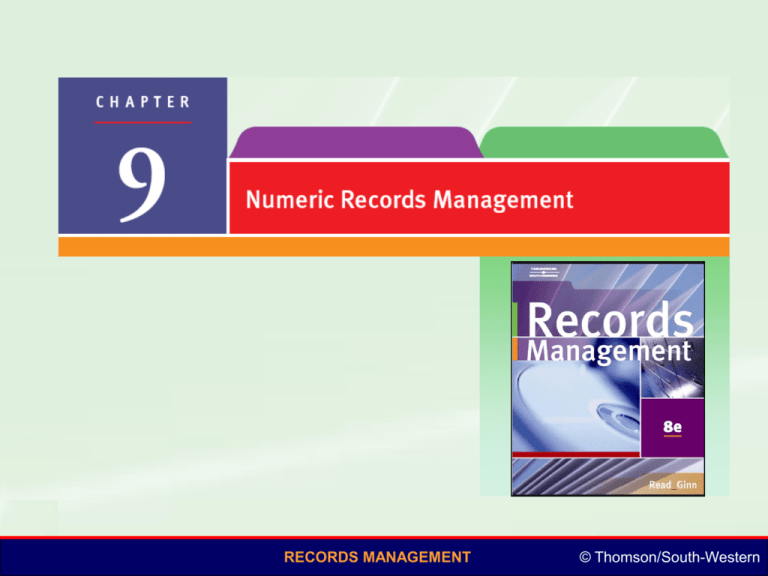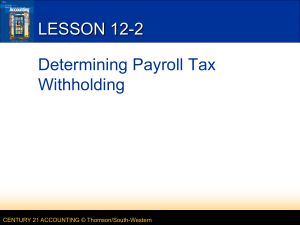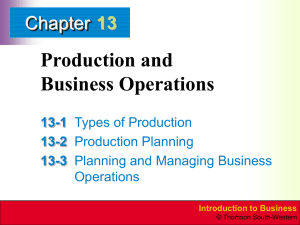Chapter 9
advertisement

CHAPTER 9 Slide 1 RECORDS MANAGEMENT © Thomson/South-Western CHAPTER 9 Slide 2 Numeric Records Management Any classification system for arranging records that is based on numbers: Consecutive numbering Nonconsecutive numbering Numeric coding used in combination with geographic or subject filing RECORDS MANAGEMENT © Thomson/South-Western CHAPTER 9 Slide 3 Consecutive Numbering Method Consecutively numbered records are arranged in ascending number order— from the lowest number to the highest number. RECORDS MANAGEMENT © Thomson/South-Western CHAPTER 9 Slide 4 Consecutive Numbering Components Numbered file Alphabetic file Accession log Alphabetic index RECORDS MANAGEMENT © Thomson/South-Western CHAPTER 9 Slide 6 Numbered Guides and Folders One guide for every ten folders RECORDS MANAGEMENT © Thomson/South-Western CHAPTER 9 Slide 7 Alphabetic Guides and Folders The general alphabetic file should be placed at the beginning of the numeric file. RECORDS MANAGEMENT © Thomson/South-Western CHAPTER 9 Slide 8 Accession Log An accession log is a serial list of numbers assigned to records in a numeric storage system. RECORDS MANAGEMENT © Thomson/South-Western CHAPTER 9 Slide 9 Example of an Accession Log RECORDS MANAGEMENT © Thomson/South-Western CHAPTER 9 Slide 10 Alphabetic Index An alphabetic index is a reference to a numeric file that is used when the name or subject is known but not the assigned number. RECORDS MANAGEMENT © Thomson/South-Western CHAPTER 9 Slide 11 Example of an Alphabetic Index RECORDS MANAGEMENT © Thomson/South-Western CHAPTER 9 Slide 12 Steps for Coding Records Coding Sorting Number coding RECORDS MANAGEMENT © Thomson/South-Western CHAPTER 9 Slide 13 Coding Code the filing segment Write an X in the margin beside crossreference names or subjects Underline the cross-reference with a wavy line RECORDS MANAGEMENT © Thomson/South-Western CHAPTER 9 Slide 14 Sorting Sort records that do not have preprinted numbers alphabetically before referencing the alphabetic index RECORDS MANAGEMENT © Thomson/South-Western CHAPTER 9 Slide 16 Advantages of Consecutive Numbering Rapid re-filing Easy and unlimited expansion Easy transfer of inactive records Cross-references are in general file Built-in security Same numeric code for all records for one customer Labeling takes less time Easy detection of misfiled records RECORDS MANAGEMENT © Thomson/South-Western CHAPTER 9 Slide 17 Disadvantages of Consecutive Numbering Requires reference to alphabetic index Requires more guides More time-consuming Congestion Numbers can be easily transposed RECORDS MANAGEMENT © Thomson/South-Western CHAPTER 9 Slide 18 Terminal-Digit Storage Terminal-digit storage—numeric storage method in which the last two or three digits are used as the primary division under which a record is filed Numbers are divided into groups separated by a space or a hyphen Numbers are read from right to left The end digits are the terminal digits RECORDS MANAGEMENT © Thomson/South-Western CHAPTER 9 Slide 19 Terminal-Digit Number Groups 35-14-65 Terminal Digits RECORDS MANAGEMENT © Thomson/South-Western CHAPTER 9 Slide 20 Terminal-Digit Number Groups— Order in the File Terminal Digits RECORDS MANAGEMENT © Thomson/South-Western CHAPTER 9 Slide 21 Middle-Digit Storage Numbers are divided into groups separated by a space or a hyphen. The middle group—middle digits—are used as the primary filing division. Numbers are read from middle to left to right. RECORDS MANAGEMENT © Thomson/South-Western CHAPTER 9 Slide 22 Middle-Digit Number Groups 35-14-65 Middle Digits RECORDS MANAGEMENT © Thomson/South-Western CHAPTER 9 Slide 23 Terminal-Digit and Middle-Digit Arrangements Terminal-Digit Middle-Digit RECORDS MANAGEMENT © Thomson/South-Western CHAPTER 9 Slide 24 Chronologic Storage Records filed in date sequence—most recent on top, or oldest on top. Principle followed in all storage methods. 5.30.02 2.14.04 9.13.05 7.11.06 RECORDS MANAGEMENT © Thomson/South-Western CHAPTER 9 Slide 25 Numeric Coding Systems Block-Numeric Duplex-Numeric Decimal-Numeric Alphanumeric Groups of numbers represent primary and secondary subjects. Numbers with two or more parts separated by a dash, space, or comma. Records are classified by subject in units of ten. Combination of letters, numbers, and punctuation marks. RECORDS MANAGEMENT © Thomson/South-Western CHAPTER 9 Slide 26 Duplex-Numeric Example RECORDS MANAGEMENT © Thomson/South-Western CHAPTER 9 Slide 27 Alphanumeric Example RECORDS MANAGEMENT © Thomson/South-Western CHAPTER 9 Slide 28 Databases for Numeric Storage Database software can simplify creation of the accession log and the alphabetic index. All information can be kept in one database table. The sort function can sort file code numbers for the accession log. RECORDS MANAGEMENT © Thomson/South-Western









